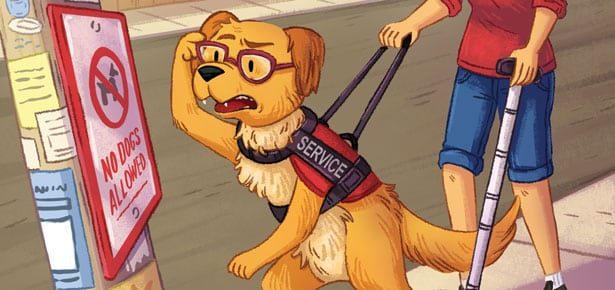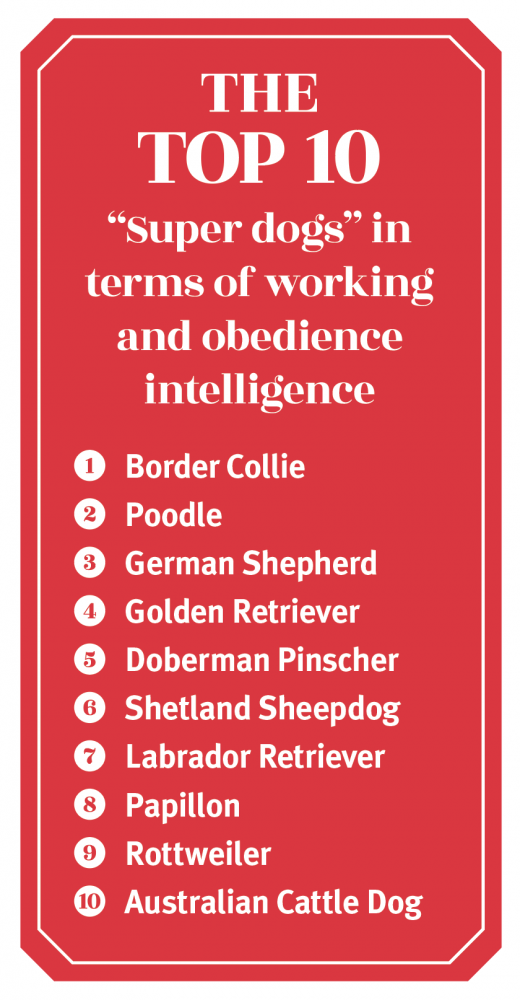

How To Teach Your Dog To Read (Yes, Really)
A pioneer in the training of Service Dogs proves that dogs can, in fact, be taught to read. Here’s how and why you should teach your dog to read
 Imagine a guide dog for the visually impaired who, when his owner says,“Find the exit,” immediately moves to the closest door that provides a way out. Imagine that this dog can also find the appropriate men's or women's lavatory when his owner asks him to “Find the washroom.” Even better, imagine that this dog can notice the areas in its environment that are posted “Danger! Keep out” and then guides his charge away from such hazards. Now exactly which abilities would it take for a dog to be able to do such things? For a human, such tasks are fairly straightforward. A person can simply scan his surrounds and look for the signs which indicate “Exit,”“Men” or “Women” or “Danger.” To utilize the information on those signs, of course, the individual has to know how to read. So now we must ask, “Can dogs be taught to read?”
Imagine a guide dog for the visually impaired who, when his owner says,“Find the exit,” immediately moves to the closest door that provides a way out. Imagine that this dog can also find the appropriate men's or women's lavatory when his owner asks him to “Find the washroom.” Even better, imagine that this dog can notice the areas in its environment that are posted “Danger! Keep out” and then guides his charge away from such hazards. Now exactly which abilities would it take for a dog to be able to do such things? For a human, such tasks are fairly straightforward. A person can simply scan his surrounds and look for the signs which indicate “Exit,”“Men” or “Women” or “Danger.” To utilize the information on those signs, of course, the individual has to know how to read. So now we must ask, “Can dogs be taught to read?”
One person who asked this question—specifically about whether dogs assisting the visually impaired could be taught to be literate—is Dr. Bonnie Bergin. She is a remarkable woman who is credited with inventing the concept of the Service Dog to assist people with mobility limitations. That was back in 1975. She later went on to found Bergin University of Canine Studies. Its campus is in Penngrove, CA and it is the only university in North America where you can get a Bachelor of Science or a master’s degree in canine studies. Dr. Bergin's graduate training was in special education (for people not puppies) and, over the years, she was able to show that using the same kind of educational practices that you use for young children works well when you are trying to train dogs to perform fairly complicated activities.
But do dogs have an adequate level of intelligence to allow them to learn to read? There has now been a lot of research which has confirmed the fact that the average dog has an intelligence which is equivalent to a human child around two to two-and-a-half years of age, while the “super dogs” (the breeds in the top 20 percent of canine intelligence) have mental abilities equivalent to a human child aged two-and-a-half to three years. Although having the mental ability of a human toddler is good, it really isn't good enough to allow a dog to learn to read canine classics (like Call of the Wild). We don't actually expect toddlers to read continuous text, however they spontaneously do learn to recognize some signs, some alphabetic letters, perhaps a printed version of their name, as well as various logos that they are exposed to on a regular basis. In other words, they are capable of word and symbol recognition. That should be okay since, after all, a word is nothing more than a visual pattern which happens to have designated significance.
“The average dog has the intelligence of a human child around two to two-and-a-half years of age, while the “super dogs” (the breeds in the top 2% of canine intelligence) have mental abilities equivalent to a human child aged two-and-a-half to three years.”
Before you start teaching your own dog to read, your pup must know a few commands and reliably respond to them when given a verbal or a hand signal. For the average dog, the commands: sit, down, stand, turn, come, roll over, touch, and so forth will work fine. Before you start, you will need to make flashcards for the four or five behaviours your dog knows best. You can make the flashcards by printing the words by hand in large block letters using a felt tip pen. You can also use your computer, just choose the largest, darkest font and avoid any typeface with squiggles, serifs or other fancy elaborations. Print one word per page in black ink on plain white sheets of paper, printed sideways (landscape orientation). You can laminate the cards or slip them into plastic page protectors to make them more durable since nose prints and drool marks will be distracting for your novice reader.
Begin with a command that your dog knows well—just not “sit,” since your dog is probably already sitting because virtually every exercise starts that way. Instead, try “down.” Show the flash card, say the command, move the flash card out of sight, and reward the dog with a desirable treat when he lays down. Keep going like this for a few trials, and then see if the dog responds when you simply hold up the flash card. Use short sessions, and don't overload the dog.
Learning the second word will be more difficult, since it is likely that the dog is initially just responding to the appearance of the flash card, and not carefully scrutinizing the word printed on it. So, let's say that that second word is “sit.” Now with a dog standing, show the flash card, say the command, drop the flash card, and, if he responds correctly, reward the dog. He will get confused at first because now he has to carefully inspect what is written on the card, but with patience he will work it out. The next step is to mix up the two words (sit, down, down, sit, and so forth), making sure that your dog is always starting from a standing position. Once your dog is doing this well, you can add a third word and then slowly proceed from there. [Want further instruction? Due to the interest so many people had in teaching dogs to read, Dr. Bergin wrote a book outlining the process step-by-step. It is titled Teach Your Dog to Read.]
Illustration by Michelle Simpson
I have verified that you can use the same principles to teach your dog to respond to logos or symbols, and this gives you an opportunity to control your dog's behaviour even when you're not around. It helps if you have already taught your dog the command “Leave It.” For my dogs, this command is interpreted as No! or Stop That! or Stay Away! The symbol which I use on the flash card is the universal sign for something that is banned, namely a circle with a slash through it (Ø). Teaching the recognition of this is a little bit harder, but worth the effort.(You'll probably have to keep the dog on leash until he learns because you may need some extra control here.)
Basically, you set up a situation with something the dog desires, say some treats. Put a few treats in your hand or on a dish, show it to the dog. When he approaches it, give the verbal “Leave It!” At the same time, you interpose the flash card with the Ø symbol. When the dog stops trying to get to them, he is praised, the flash card is dropped, and he gets a treat. This takes lots of practice because, like a toddler, the average dog does not have wonderful impulse control. But it is worth the effort.
You see, once the dog has learned the "Leave It!" symbol, you can designate places where you don't want the dog to go. Prop up a flash card with the Ø symbol on the kitchen counter to help deter a dog from surfing that surface for edibles. You can also prop that symbol up on a piece of furniture that you don't wish the dog to go onto in the same way that you put up a “Keep off the Grass” sign to keep people from tromping all over your lawn. (Yes, this actually works if taught properly.)
Dr. Bergin now routinely has her service dogs learn to read a dozen or so words and symbols. She claims that dogs can learn 20 or more words. But it takes hard work and patience. Her enthusiasm about this process is evident when she says, “The possibilities for reading dogs are endless.When you teach a dog to read, you’re not just teaching him a cute trick to show your friends. You’re developing his mind and helping him become a better problem solver.”
Join the newsletter and never miss out on dog content again!
"*" indicates required fields
By clicking the arrow, you agree to our web Terms of Use and Privacy & Cookie Policy. Easy unsubscribe links are provided in every email.






